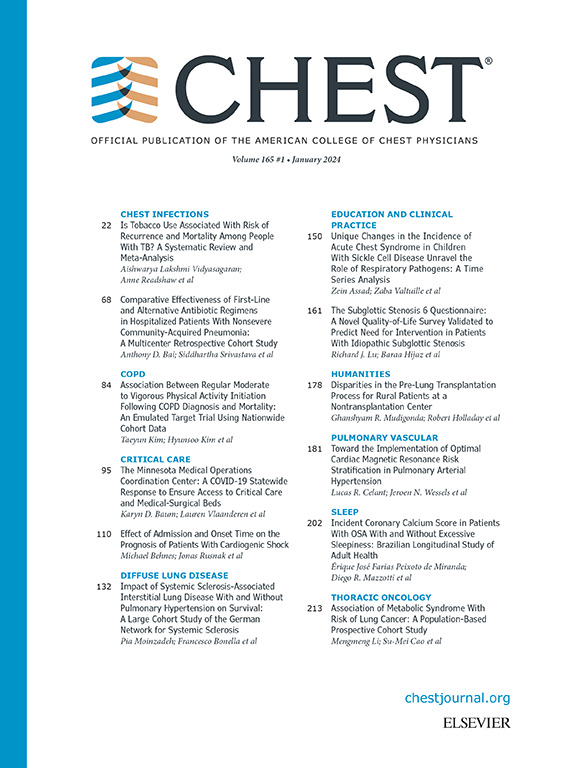Coronary Artery Calcification Identified on Lung Cancer Screening CT Scans: A Scoping Review.
IF 9.5
1区 医学
Q1 CRITICAL CARE MEDICINE
引用次数: 0
Abstract
TOPIC IMPORTANCE Coronary artery calcification (CAC) can be a significant incidental finding on low-dose computed tomography (CT) scans performed for lung cancer screening (LCS). CAC presence and grade hold important diagnostic, and preventive value, particularly in patients without previously recognized coronary artery disease. This scoping review describes the prevalence of CAC as an incidental finding on LCS CT scans across prior studies and identifies directions for future research. REVIEW FINDINGS The initial search resulted in 256 abstracts screened for eligibility, resulting in 32 articles included in the final review. CAC presence across included studies varied from 14.8% to 98%. CAC was most commonly reported as mild in grade, among 46.9% of studies. The majority of studies were conducted among predominantly White male participants. Finally, only 6 articles provided information on down-stream interventions for patients with newly detected CAC. SUMMARY CAC, a predictive risk factor for cardiovascular events and mortality, is a frequently detected incidental finding on LCS CT scans, with substantial variation in presence across studies. Identification of CAC on LCS CT could inform clinical decisions to reduce patients' overall cardiovascular risk. These findings underscore the significance of standardizing the documentation and management of CAC in LCS. Finally, future studies should include greater race diversity.肺癌筛查 CT 扫描中发现的冠状动脉钙化:范围综述。
主题重要性冠状动脉钙化(CAC)可能是肺癌筛查(LCS)低剂量计算机断层扫描(CT)中一个重要的偶然发现。CAC的存在和分级具有重要的诊断和预防价值,特别是在先前未发现冠状动脉疾病的患者中。这篇范围综述描述了CAC的流行是在LCS CT扫描中偶然发现的,并确定了未来研究的方向。初步检索结果筛选出256篇符合条件的摘要,最终纳入32篇文章。在纳入的研究中,CAC的存在从14.8%到98%不等。在46.9%的研究中,CAC最常被报道为轻度。大多数研究是在白人男性参与者中进行的。最后,只有6篇文章提供了新发现CAC患者的下游干预信息。ycac是心血管事件和死亡率的预测危险因素,是LCS CT扫描中经常发现的偶然发现,在各研究中存在很大差异。在LCS CT上识别CAC可以为临床决策提供信息,以降低患者的总体心血管风险。这些发现强调了在LCS中标准化CAC记录和管理的重要性。最后,未来的研究应该包括更大的种族多样性。
本文章由计算机程序翻译,如有差异,请以英文原文为准。
求助全文
约1分钟内获得全文
求助全文
来源期刊

Chest
医学-呼吸系统
CiteScore
13.70
自引率
3.10%
发文量
3369
审稿时长
15 days
期刊介绍:
At CHEST, our mission is to revolutionize patient care through the collaboration of multidisciplinary clinicians in the fields of pulmonary, critical care, and sleep medicine. We achieve this by publishing cutting-edge clinical research that addresses current challenges and brings forth future advancements. To enhance understanding in a rapidly evolving field, CHEST also features review articles, commentaries, and facilitates discussions on emerging controversies. We place great emphasis on scientific rigor, employing a rigorous peer review process, and ensuring all accepted content is published online within two weeks.
 求助内容:
求助内容: 应助结果提醒方式:
应助结果提醒方式:


